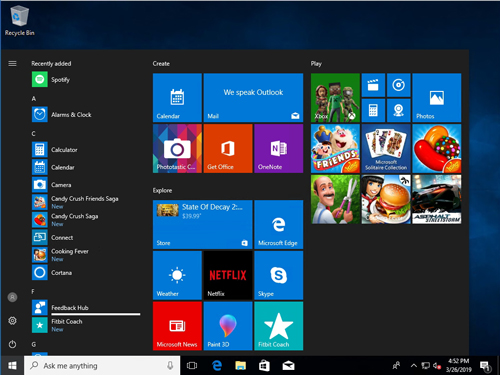Posey's Tips & Tricks
It's OK If Microsoft Abandons Live Tiles
What started out as a handy shortcut to your most-used Windows 10 apps has morphed into another way for Microsoft and developers to pepper you with ads.
Way back in 2010, I had a publisher approach me about writing a book on the soon-to-be-released Windows Phone 7 operating system. As I wrote the book and gained familiarity with the phone's OS, I couldn't help but get the sense that Microsoft was using Windows Phone 7 to try out new features that it was considering integrating into the forthcoming Windows 8 OS. One such feature was live tiles.
For those who might not be familiar with live tiles, they are essentially just Start menu tiles that are capable of actively conveying information. For example, a tile might display the weather forecast or an upcoming appointment. I still use a Windows Phone to this day, and one of the live tiles on my phone's Start screen rotates pictures from my photo collection, while another displays photos of my contacts. Yet another live tile lists my next upcoming appointment.
If I am to be brutally honest, I confess that I have mixed feelings about live tiles. When live tiles were first introduced nearly a decade ago, I was very much intrigued by the idea. At the time, I viewed Windows live tiles as a shortcut because they are able to expose application information from outside of the application. The Outlook tile on my phone's Start screen, for example, displays a counter showing how many new e-mail messages I have received. This means I don't have to waste time opening Outlook to see if I have any new mail; I can just look at the counter on the Start screen.
Although I still believe that live tiles can be legitimately useful, I also think that some of the use cases we have seen over the past few years call into question whether the benefits of live tiles outweigh the potential abuses.
If you don't know what I am talking about with regard to potential abuses, look no further than the default Windows 10 Start menu. Microsoft switches up the default menu's contents from time to time, but check out this screen capture from three months ago:
 [Click on image for larger view.] Figure 1: This is the default Windows 10 Start menu.
[Click on image for larger view.] Figure 1: This is the default Windows 10 Start menu.
Although the default Start menu shown above contains about two dozen live tiles, none of those live tiles are displaying anything useful. Instead, Microsoft has used live tiles as a tool for monetizing the Start menu. For instance, the screen capture contains advertisements for Microsoft Office and for an app called "State of Decay 2." Many of the other tiles are being used to promote bloatware.
Keep in mind that these are just the default live tiles. There are also third-party developers who have created some really obnoxious live tiles that flash and change colors in an effort to draw the user's attention.
Obviously, there are both good and bad aspects to live tiles, and at this point I haven't quite decided how I feel about them. Regardless, there is at least some evidence to suggest that live tiles might be going away. A few weeks ago, Microsoft acknowledged that it had accidentally released Windows 10 build 18947 to a small group of Windows Insiders. On the surface, this incident might be dismissed as nothing more than an easily forgettable mistake. The thing that got everyone's attention, however, was that this particular build did away with the live tiles.
Rumor has it that Microsoft is building a new operating system called Windows Lite, and that one of the ways in which Windows is going to be slimmed down is through the removal of live tiles. Some have further speculated that Microsoft will be bringing a similar option to Windows 10.
My guess is that Microsoft probably won't be including a switch in Windows 10 that can be used to turn off the live tiles. Instead, I think that Microsoft may be planning to do something similar to what it has done with Windows 10's "S Mode." I think that it may eventually be possible to toggle the OS between a full mode and a lite mode.
For right now, though, all we have are rumors, so we will have to wait and see how this plays out.
About the Author
Brien Posey is a 22-time Microsoft MVP with decades of IT experience. As a freelance writer, Posey has written thousands of articles and contributed to several dozen books on a wide variety of IT topics. Prior to going freelance, Posey was a CIO for a national chain of hospitals and health care facilities. He has also served as a network administrator for some of the country's largest insurance companies and for the Department of Defense at Fort Knox. In addition to his continued work in IT, Posey has spent the last several years actively training as a commercial scientist-astronaut candidate in preparation to fly on a mission to study polar mesospheric clouds from space. You can follow his spaceflight training on his Web site.